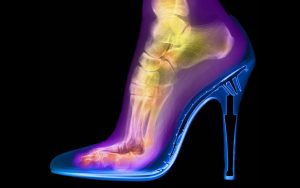
How do I buy a proper footwear?
How do I buy a proper footwear?
BUYING SHOES
Any injury to the foot can impact your ability to move. High heels and pointy-toed fashion shoes are natural adversaries to your feet. Although the angle of high heels may make your legs look long and graceful, it puts  pressure on the toes and upsets your complete normal balance of your feet. Keep your use of high heels to a minimum and opt for flats instead.
pressure on the toes and upsets your complete normal balance of your feet. Keep your use of high heels to a minimum and opt for flats instead.
Sport-specific shoes are engineered to provide the support, motion control, and cushioning that minimize foot injuries associated with a particular activity. Sports shoes can also be worn every day. However, they will lose their cushioning effect over time and should be replaced if the lining no longer bounces back when you press on it.
Remember to check shoes for air flow—do they have porous fabric or air holes so that your feet can breathe? The toe should be more rounded with wide toe box than pointed, resembling the natural shape of the foot. With one hand on the heel and the other on the toe, try to bend the shoe—does it give? If it doesn’t flex, it’s probably too stiff. Next, place the shoe on the floor and push it forward—is there any resistance? Shoes with poor tread design or smooth bottoms can lead to slips and falls.
Although shoe construction certainly matters, fit is really the key element in keeping your feet healthy. Consider getting your feet measured. Your feet may well have increased in size as you age. Be sure to shop for shoes at the end of the day, when your feet are larger due to activity. Measure both feet, since they are often different sizes, and always fit to the larger size. Allow 1/2″ of room between your longest toe and the end of the shoe. Feel along the sides of the shoe while it’s on your foot to check that the widest part of your foot corresponds with the widest part of the shoe. Take a test stroll across the store to verify that the shoe flexes when you walk, and that your heel doesn’t slip in and out. Wear the hosiery or socks you expect to wear with the shoes.
The most important test of all is completely subjective: Are they comfortable? A particular pair of shoes may look great, but if they’re going to leave you sore or limping, leave them in the store. Be kind to your feet—they’ve got to carry you a long way.
AT THE END OF THE DAY WEAR WHAT IS COMFORTABLE TO YOUR FOOT AND NOT WHAT IS LOOKING GOOD. FOOT WEAR CAN BE CHANGED BUT NOT YOUR OWN FEET.
ALSO READ


How To Choose The Ideal Paper Writing Service
Posted On 24 May 2023
When you use a paper writing service, then you are picking a company that's devoted to your needs. They are…
APA Live Chat – The Way I Could Write My Paper?
Posted On 8 May 2023
If you've got a big test coming up and you need to have it done on time, and then you…
How to Write My Paper Cheaply
Posted On 7 May 2023
There are many ways to compose my paper inexpensively. In fact, some approaches can actually save money for the writer.…
Posted On 4 May 2023
Have Fun and Enjoy a Fun Way to Enjoy your time at home by playing free slots at the casino…
How to Write My Essay About Writing Sample Papers
Posted On 23 Apr 2023
Are you worried about how to write my own article? I understand, it's somewhat intimidating when you first begin learning…

College Application Essay Writing Service Voucher Reddit.com
Posted On 12 Apr 2023
This will suggest having a apparent being familiar with of the supply material or the subject and sticking shut to…

Quality Custom Essay Writing Service Reddit.com
Posted On 12 Apr 2023
Many universities present distinctive deals with savings which you could uncover fascinating. This way you will hardly ever free the…
Reddit Custom Essay Writing Service For Cheap
Posted On 12 Apr 2023
The Looming Questions: Will the reserve be a accomplishment or not? How considerably would this maximize your composing money? Now,…
Reddit Essay Writing Service Atlanta Ga
Posted On 11 Apr 2023
Pretty much as vital as firm any time you are producing essays, is concept generation. Nothing at all will kill…
Reddit.com Persuasive Essay Writing Service Online
Posted On 11 Apr 2023
As aspect of the organizing for faculty admissions, a timeline ought to be established in progress. Consequently, your site visitors…